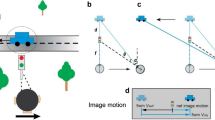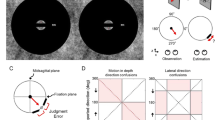Abstract
Visually perceived motion can affect observers’ motor control in such a way that an intended action can be activated automatically when it contains similar spatial features. So far, effects have been mostly demonstrated with simple displays where objects were moving in a two-dimensional plane. However, almost all actions we perform and visually perceive in everyday life are much more complex and take place in three-dimensional space. The purpose of this study was to examine action inductions due to visual perception of motion in depth. Therefore, we conducted two Simon experiments where subjects were presented with video displays of a sphere (simple displays, experiment 1) and a real person (complex displays, experiment 2) moving in depth. In both experiments, motion direction towards and away from the observer served as task irrelevant information whereas a color change in the video served as relevant information to choose the correct response (close or far positioned response key). The results show that subjects reacted faster when motion direction of the dynamic stimulus was corresponding to the spatial position of the demanded response. In conclusion, this direction-based Simon effect is modulated by spatial position information, higher sensitivity of our visual system for looming objects, and a high salience of objects being on a collision course.




Similar content being viewed by others
Notes
Colors were chosen for the same reasons as described in Classen and Kibele (2015).
With this experimental condition we wanted to examine a small question alongside that is not of further interest for the main hypotheses of our study. For this reason we will outline the results of this condition but will subsequently not address it any further.
Note: all participants used their right index finger to press the proximal key and their left index finger to press the distal key. To rule out impacts of handedness in this experiment, we replicated experiment 1 with changed index finger to response key mapping (n = 5). The results were similar and allowed us to assume that handedness is no factor of influence here.
One might argue that the stimulus is becoming smaller from the close to the far position and that a size effect is responsible for the different magnitudes of the Simon effects. It is well known that stimulus size affects simple reaction time in such a way that reaction times are shorter to larger as to smaller stimuli. Nevertheless, this only holds for stimuli smaller than 0.5° (e.g. Froeberg, 1907; O’Donell, Barraza, & Colombo, 2010). The stimulus size at the far position corresponds to a visual angle of 1.2° (with a viewing distance of 70 cm). Therefore, reaction times should not be affected by stimulus size here.
In an experiment of our own conducted in our lab, we tested choice reaction times with different colors on different backgrounds and found that there was no difference between the color magenta (RGB 255, 0, 255) and green (RGB 0, 255, 0) on a gray background (RGB 128, 128, 128) (Hofmann, 2012).
References
Bortz, J. (1999). Statistik: Für Sozialwissenschaftler [Statistics: For Social Scientists] (5th ed.). Berlin: Springer.
Bosbach, S., Prinz, W., & Kerzel, D. (2004). A Simon effect with stationary moving stimuli. Journal of Experimental Psychology: Human Perception and Performance, 30(1), 39–55. doi:10.1037/0096-1523.30.1.39.
Bosbach, S., Prinz, W., & Kerzel, D. (2005). Is direction position? Position- and direction-based correspondence effects in tasks with moving stimuli. The Quarterly Journal of Experimental Psychology Section A, 58(3), 467–506. doi:10.1080/02724980443000016.
Box, G. E. P. (1954). Some theorems on quadratic forms applied in the study of analysis of variance problems, II. Effects of inequality of variance and of correlation between errors in the two-way classification. The Annals of Mathematical Statistics, 25(3), 484–498. doi:10.1214/aoms/1177728717.
Classen, C., & Kibele, A. (2015). Action induction by visual perception of rotational motion. Psychological Research,. doi:10.1007/s00426-015-0693-6.
De Jong, R., Liang, C.-C., & Lauber, E. (1994). Conditional and unconditional automaticity: a dual-process model of effects of spatial stimulus-response correspondence. Journal of Experimental Psychology: Human Perception and Performance, 20(4), 731–750. doi:10.1037/0096-1523.20.4.731.
Dent, K., & Humphreys, G. W. (2011). Neuropsychological evidence for a competitive bias against contracting stimuli. Neurocase, 17(2), 112–121. doi:10.1080/13554794.2010.498381.
Fitts, P. M. (1954). The information capacity of the human motor system in controlling the amplitude of movement. Journal of Experimental Psychology, 47(6), 381–391. doi:10.1037/h0055392.
Franconeri, S. L., & Simons, D. J. (2003). Moving and looming stimuli capture attention. Perception and Psychophysics, 65(7), 999–1010. doi:10.3758/BF03194829.
Froeberg, S. (1907). The relation between the magnitude of stimulus and the time of reaction. Archives of Psychology, 16(8), 1–38.
Geisser, S., & Greenhouse, S. W. (1958). An extension of Box’s results on the use of the F-distribution in multivariate analysis. The Annals of Mathematical Statistics, 29(3), 885–891. doi:10.1214/aoms/1177706545.
Hays, W. L. (1994). Statistics (5th ed.). Fort Worth: Harcourt Brace College Publishers.
Hofmann, J. (2012). Der Einfluss von Farbe auf die Reaktionszeit im Wettkampfsport: eine empirische Grundlagenuntersuchung zur Frage danach, ob der Vorteil bestimmter Kleiderfarben im Wettkampfsport auf farbabhängige Reaktionszeiten zurückgeführt werden kann [Impact of color on reaction time in competitive sports: A basic examination about the question whether the advantage of special colors of sportswear is due to color dependent reaction times]. Unpublished master‘s thesis. University of Kassel.
Hommel, B. (1996). The cognitive representation of action: automatic integration of perceived action effects. Psychological Research, 59(3), 176–186. doi:10.1007/BF00425832.
Hommel, B., Müsseler, J., Aschersleben, G., & Prinz, W. (2001). The theory of event coding (TEC): a framework for perception and action planning. Behavioral and Brain Sciences, 24, 849–937. doi:10.1017/S0140525X01000103.
Jouen, F., Lepecq, J.-C., Gapenne, O., & Bertenthal, B. I. (2000). Optic flow sensitivity in neonates. Infant Behavior & Development, 23, 271–284. doi:10.1016/S0163-6383(01)00044-3.
Kornblum, S., Hasbroucq, T., & Osman, A. (1990). Dimensional overlap: cognitive basis for stimulus-response compatibility—a model and taxonomy. Psychological Review, 97(2), 253–270. doi:10.1037/0033-295X.97.2.253.
Lin, J. Y., Franconeri, S., & Enns, J. T. (2008). Objects on a collision path with the observer demand attention. Psychological Science, 19(7), 686–692. doi:10.1111/j.1467-9280.2008.02143.x.
Michaels, C. F. (1988). S-R compatibility between response position and destination of apparent motion: evidence of the detection of affordances. Journal of Experimental Psychology: Human Perception and Performance, 14(2), 231–240. doi:10.1037/0096-1523.14.2.231.
O’Donell, B. M., Barraza, J. F., & Colombo, E. M. (2010). The effect of chromatic and luminance information on reaction times. Visual Neuroscience, 27(3–4), 119–129. doi:10.1017/S0952523810000143.
Prinz, W. (1990). A Common Coding Approach to Perception and Action. In W. Prinz, P. Bieri, & O. Newmann (Eds.), Relationships Between Perception and Action. Current Approaches. Berlin: Springer.
Proctor, R. W., Van Zandt, T., Lu, C.-H., & Weeks, D. J. (1993). Stimulus-response compatibility for moving stimuli: perception of affordances or directional coding? Journal of Experimental Psychology: Human Perception and Performance, 19(1), 81–91. doi:10.1037/0096-1523.19.1.81.
Rigon, J., Massaccesi, S., & Umiltà, C. (2011). A Simon effect for depth in three-dimensional displays. The American Journal of Psychology, 124(4), 395–403. doi:10.5406/amerjpsyc.124.4.0395.
Schiff, W., Caviness, J. A., & Gibson, J. J. (1962). Persistent fear responses in rhesus monkeys to the optical stimulus of “looming”. Science, 136(3520), 982–983. doi:10.1126/science.136.3520.982.
Skarratt, P., Cole, G., & Gellatly, A. H. (2009). Prioritization of looming and receding objects: equal slopes, different intercepts. Attention, Perception, & Psychophysics, 71(4), 964–970. doi:10.3758/APP.71.4.964.
Stins, J. F., & Michaels, C. F. (1997). Stimulus-response compatibility is information-action compatibility. Ecological Psychology, 9(1), 25–45. doi:10.1207/s15326969eco0901_2.
Takeuchi, T. (1997). Visual search of expansion and contraction. Vision Research, 37(15), 2083–2090. doi:10.1016/S0042-6989(96)00225-8.
von Mühlenen, A., & Lleras, A. (2007). No-onset looming motion guides spatial attention. Journal of Experimental Psychology: Human Perception and Performance, 33(6), 1297–1310. doi:10.1037/0096-1523.33.6.1297.
Wittfoth, M., Buck, D., Fahle, M., & Herrmann, M. (2006). Comparison of two Simon tasks: neuronal correlates of conflict resolution based on coherent motion perception. NeuroImage, 32(2), 921–929. doi:10.1016/j.neuroimage.2006.03.034.
Author information
Authors and Affiliations
Corresponding author
Ethics declarations
Ethical standards
All experiments of this study have been performed in accordance with the ethical standards laid down in the 1964 Declaration of Helsinki and its later amendments. All participants gave their informed consent prior to their inclusion in the study.
Rights and permissions
About this article
Cite this article
Classen, C., Kibele, A. Action induction due to visual perception of linear motion in depth. Psychological Research 81, 131–142 (2017). https://doi.org/10.1007/s00426-015-0724-3
Received:
Accepted:
Published:
Issue Date:
DOI: https://doi.org/10.1007/s00426-015-0724-3




